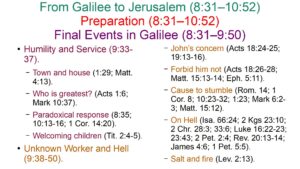Jesus from Galilee to Jerusalem
Mark 8:31–10:52
Preparation
First Prediction of Death and Resurrection (8:31).
The Kingdom is Near (1:15; 9:1)
Final Events in Galilee (8:31–9:50).
Call for Commitment (8:31–9:1).
Transfiguration (9:2-8).
Elijah’s Coming (9:9-13).
Healing an Epileptic (9:14-29).
Second Prediction of Death and Resurrection (9:31)
Kingdom Has Small Beginnings (4:3-32; 10:29-31)
Second Prediction (9:30-32).
Humility and Service (9:33-37).
Unknown Worker and Hell (9:38-50).
John’s concern (9:38).
Forbid him not (9:39-41).
Cause to stumble (9:42).
This whole section carries with it similarities to Jesus’ Sermon on the Mount in Matthew 5, but it has a direct parallel to Matthew 18:6-9 and Luke 17:1-2.
Vss. 44 and 46 are not in certain key manuscripts, which isn’t a big deal at all since both are a repetition of vs. 48 and is a quote from the last verse in Isaiah (Isa. 66:24).
Vss. 43, 45, and 47 are all parallel illustrations on the severity of sin and hell.
Jesus is not literally telling us to maim ourselves, but that eternal life is far more important than anything physical in this life—even our own body parts.
What are you willing to give up for heaven?
With the hand, foot, and eye, we see other parallels, too.
9:43 hand enter into life go to hell
9:45 foot enter life cast into hell
9:47 eye enter the kingdom of God cast into hell fire
This word for hell is Gehenna, or Valley of Hinnom.
In the OT, this valley was where the people under evil kings such as Ahaz and Manasseh sacrificed children to the Baals and the Ammonite god Molech (2 Kgs 23:10; 2 Chron. 28:3; 33:6).
The place became such a source of hatred and disgust that it became Jerusalem’s city dump where the fire burned continually. Everything disposable, unclean, and putrid was thrown out there.
This Valley of Hinnom was a perfect illustration to show what hell was like, the place of unquenchable fire for the unclean sinner as Isaiah describes.
This is not Hades, the holding place of the dead that we see divided into Abraham’s bosom (or Paradise) and Torments (Luke 16:22-23; 23:43). This is also not Tartarus where the evil spirits await judgment (2 Pet. 2:4). This is the final destination of those who die outside of Christ upon the Day of Judgment, the lake of fire (Rev. 20:13-14).
This is the second death, but it is not a release, since not even the worm (or maggot) dies there.
What are you willing to give up to avoid this place? In context, are you willing to give up your pride and haughtiness? “God resists the proud, but gives grace to the humble” (James 4:6; 1 Pet. 5:5).
Salt and fire (9:49-50).
It would seem that Jesus is making a shift here, that the fire is no longer a reference to hellfire, but to struggles and trials.
Everyone will be seasoned with it, that is we all will experience suffering here on earth.
Keep in mind Mark’s primary audience is the Roman Christians about to undergo great persecution—seasoned with fire. They might experience a literal burning here on earth, but through it the faithful avoid the eternal fire in hell.
Jesus (or perhaps Mark) reminds us that sacrifices are already seasoned with salt (Lev. 2:13), linking this salt to the fiery trials they would soon face.
Then there is another shift in meaning concerning the salt (if the link presented in 9:49b should even be there).
I think we in the South can all agree that salt is good—perhaps too good.
But in this context, pride and humility are a central idea. As one commentator states, “The salt referred to in verse 50 is probably the humility and dedication that is reinforced by trial and testing. If the believer loses this salt he or she is not easily renewed, but by maintaining this salt, Jesus’ followers can more easily be at peace with one another. The simple purity of dedication to Jesus that does not seek its own advantage enables one to be a servant to fellow disciples, and thus promotes peace” (Hurtado 156; Black 175)
So the salt here refers to the humility required for getting along with one another.
And we see that when we describe someone as the “salt of the earth,” someone who is humble that you can really get along with—being at peace with one another.
